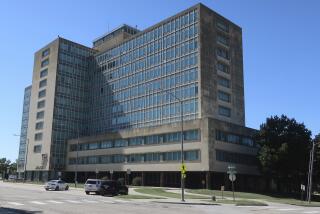Improved TARP forecast could mean $200 billion to help create jobs
- Share via
Reporting from Washington — President Obama is looking to use bailout money that banks are returning to the government to help tackle two of the nation’s biggest problems -- unemployment and the budget deficit.
As he prepared to unveil job creation ideas in a major economic speech today, Obama said he was considering tapping the $700-billion Troubled Asset Relief Program to pay for some of them. Additional money flowing back into TARP, leading to new projections lowering the fund’s long-term cost, would help reduce the ballooning deficit.
The controversial bailout fund “has turned out to be much cheaper than we expected, although not cheap,” Obama said Monday.
In a report to be sent to Congress this week, the Treasury Department estimates losses from TARP to be no more than $141 billion over the next decade. That compares with the administration’s projection in August of $341 billion in losses.
Major banks are returning the bulk of the money given them more quickly than anticipated. Bank of America Corp. said last week that it won federal approval to return $45 billion it had received, raising to $116 billion the amount expected this year from banks.
“It means that some of that money can . . . be devoted to deficit reduction,” Obama said. “And the question is, are there selective approaches that are consistent with the original goals of TARP -- for example, making sure that small businesses are still getting lending -- that would be appropriate in accelerating job growth?”
Obama today is expected to announce an initiative to give people government money to make their homes more energy efficient. The program would aim for an immediate effect similar to the popular “cash for clunkers” auto sales program, providing incentives to boost economic activity as well as help the environment.
The White House is considering several other job-creation ideas, including special tax credits for businesses hiring new workers and more government spending on roads, bridges and other infrastructure.
Some administration officials support using a portion of TARP money to help pay for the new government job-creation efforts. Aides said such a move would send the message to Americans that their economic survival is as important as that of Wall Street executives and automakers.
The fund’s original purpose was economic stability, not job creation. White House Press Secretary Robert Gibbs argued that spending TARP money to “create an environment for increased hiring for jobs” makes sense because it would help stabilize the economy.
House Speaker Nancy Pelosi (D-San Francisco) has said TARP money should be used to help pay for job-creation measures. “Creating jobs reduces the deficit,” she said.
Republicans contended that it would be a misuse of TARP funds, saying the law that created TARP requires refunds to be used to reduce the deficit. They have said that the administration was treating the program like a “slush fund” to spend on what it wants without congressional approval.
“If this money is not used for either tax relief or reduction of the deficit, the taxpayer did not get anything” from the returned money, said Rep. Jeb Hensarling (R-Texas), who serves on the congressionally created panel that oversees TARP.
With unemployment at 10%, down from 10.2% in October, House Democrats are working on a package of job-creation measures that would cost about $70 billion and include plans to increase lending to small businesses and fund more infrastructure projects.
House leaders also want to pass a $110-billion bill to extend some unemployment and health insurance benefits. Last month, the economy lost only 11,000 jobs, the lowest in two years. But even though a projected $1.5-trillion budget deficit this year is creating strong fiscal and political pressure on Congress and the White House to keep spending down, lawmakers and administration officials say they need to do more to encourage job growth.
Mark Zandi, chief economist for Moody’s Economy.com, sees little difference between using the TARP money to pay for job-creation programs and using it to reduce the deficit, which would then force Congress to appropriate more money for job programs. The net result is the same, he said.
Altogether, the government has committed almost all of the original $700 billion in TARP money, but it has doled out much less, $454.3 billion by the end of October. Financial institutions have received about $370 billion, most in direct aid and the rest to prop up bad loans and other marginal assets. About $85 billion went to automakers General Motors Corp. and Chrysler and their suppliers.
In the meantime, more banks are negotiating with the government to return funds. They include Citigroup Inc. and Wells Fargo & Co., which want to refund $45 billion and $25 billion, respectively, according to an Associated Press report.
The recovery on Wall Street has led the Obama administration to reduce its projections of losses from TARP, allowing officials to consider other uses for the money. Although Zandi estimated taxpayers still could lose $150 billion overall, the price tag is looking much smaller than it did last winter.
Obama’s 2010 budget outline warned in February that if economic conditions worsened, the fund might need an additional $750 billion. Now, however, the Treasury Department doesn’t anticipate needing more than the original TARP money, according to a department official, who spoke on condition of anonymity because the report to Congress has not yet been formally released.
In addition, losses from the fund are projected to be about $200 billion less than projected last summer. The report estimated that by the end of next year, nearly half the money spent could be returned to the Treasury Department.
“Taxpayers will pay less than previously thought, and the deficit and debt will be lower,” the official said.
Under the law that created TARP, the fund will expire at the end of the year unless the Treasury Department requests an extension through October. Administration officials have not formally made the request but are expected to do so.
jim.puzzanghera@ latimes.com
More to Read
Get the L.A. Times Politics newsletter
Deeply reported insights into legislation, politics and policy from Sacramento, Washington and beyond. In your inbox three times per week.
You may occasionally receive promotional content from the Los Angeles Times.












